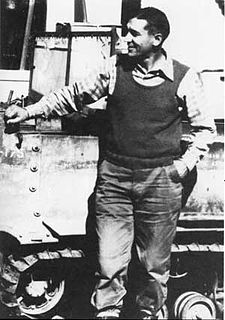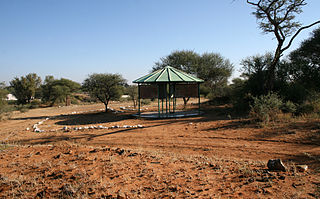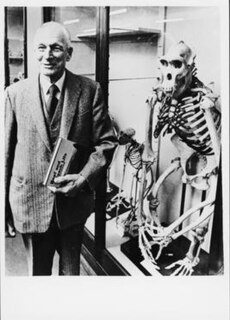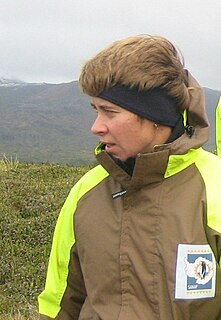
Robert Broom FRS FRSE was a British- South African doctor and palaeontologist. He qualified as a medical practitioner in 1895 and received his DSc in 1905 from the University of Glasgow.

Austin Roberts was a South African zoologist. He is best known for his Birds of South Africa, first published in 1940. He also studied the mammalian fauna of the region: his work The mammals of South Africa was published posthumously in 1951. The 7th edition of Roberts' Birds of Southern Africa which appeared in 2005, is the standard work on the region's birds.

The McGregor Museum in Kimberley, South Africa, originally known as the Alexander McGregor Memorial Museum, is a multidisciplinary museum which serves Kimberley and the Northern Cape, established in 1907.
Kimberley Boys' High School is a state secondary school or high school situated adjacent to the Honoured Dead Memorial, in the arc between Dalham and Memorial Roads, Kimberley, Northern Cape, South Africa – a site it has occupied since January 1914. The school was founded, along with what would become Kimberley Girls' High School, in 1887, under the name Kimberley Public Undenominational Schools. In July 1970 it gave rise to Kimberley Boys’ Junior School which in turn united with Belgravia Junior School in January 1977 to become what is today Kimberley Junior School.

Aldo Starker Leopold was an American author, forester, zoologist and conservationist. He also served as professor at the University of California, Berkeley for thirty years. Throughout his life, Leopold was active in numerous wildlife and conservation groups throughout the United States.
The Malay Camp in Kimberley, South Africa, was a cosmopolitan suburb which was subject to forced removals prior to the Group Areas Act.
Maria Wilman was a South African geologist and botanist. She was the first Director of the McGregor Museum in Kimberley, South Africa and the second female South African to attend the University of Cambridge in England.
John Hyacinth Power was the second Director of the McGregor Museum in Kimberley, South Africa.
Alfred Martin Duggan-Cronin was an Irish-born South African photographer who undertook several photographic and collecting expeditions in South Africa and adjacent territories between 1919 and 1939, in the course of which he documented people and rural life throughout the subcontinent. Based in Kimberley, it was while working in the mine compounds that he initially encountered African migrant workers, stimulating an interest in ethnographic subjects. Duggan-Cronin was born on 17 May 1874 in Innishannon, County Cork, Ireland, and died on 25 August 1954 in Kimberley, South Africa..

Canteen Kopje is an archaeological site, formally protected as a grade 2 provincial heritage site, and approved in 2017 for re-grading to national status, situated outside Barkly West in the Northern Cape, South Africa. The place was previously known as Klipdrift, meaning stony drift, a translation from a still earlier !Ora name, !a |aub. Canteen Kopje is best known for its long and exceptionally rich Earlier Stone Age sequence, spanning circa >0.5 to 1.7 million years, occurring within gravels exposed in late nineteenth/early twentieth century mining pits. Also attracting attention are more recent archaeological levels in the overlying Hutton Sands, which contain material known as Fauresmith, Middle Stone Age, Later Stone Age, and late Iron Age with evidence of protocolonial/colonial contact and interaction, probably, with nineteenth century diamond diggers.
Richard Liversidge, naturalist, ornithologist and museum director, was born on 17 September 1926 in Blantyre, Nyasaland, and died on 15 September 2003 in Kimberley, South Africa.

William Roy McGregor was a New Zealand zoologist and conservationist who was successful in halting forestry in the Waipoua forest and establishing the forest as a protected sanctuary.
This is a list of the famous and notable people from Kimberley, Northern Cape, South Africa.
Rudolph Bigalke was the third director of the National Zoological Gardens of South Africa, from 1927 to 1962.
David Mark Richardson is a South African ecologist, particularly known for his work on invasive species, especially invasive trees and shrubs.
Ridwan Laher, was a South African university professor in political science, an independent political consultant and a research associate of the McGregor Museum in Kimberley, South Africa. He was born in Johannesburg on 5 June 1964 and died in Kimberley on 2 July 2014.
Leopoldt van Huyssteen was the acting Rector and Vice-Chancellor of Stellenbosch University, South Africa, following the unexpected death of the previous office bearer Prof Russel Botman on 28 June 2014. Prof Wim de Villiers was appointed to the position permanently at the end of 2014.

Richard Marshall Eakin, was an American zoologist and professor at the University of California, Berkeley. He was widely known for portraying prominent historical scientists during some of his lectures; dressing in costume and speaking in character to entertain and inform his students. A 1953 Guggenheim fellow, he wrote several books and more than 200 scientific papers. His research focused on eyes and vision in animals, especially the parietal eye or "third eye" of vertebrates, as well as animal embryology. He served as chairman of the UC Berkeley Department of Zoology for over 10 years, was elected president of the Western Society of Naturalists and American Society of Zoologists, and was a fellow of the California Academy of Sciences.

Bettine van Vuuren is the Senior Director: Strategic Initiatives and Administration at the University of Johannesburg. She is also a Professor of Zoology and Director of the Centre for Ecological Genomics and Wildlife Conservation at the University of Johannesburg.

Peter Bernhard Beaumont was a South African archaeologist noted for his excavation and finds at Wonderwerk Cave, Kathu, Canteen Kopje and Border Cave, all in South Africa. His work led to the conviction that, rather than trailing Europe and Asia, Southern Africa's Stone Age technology and culture had set the pace.








